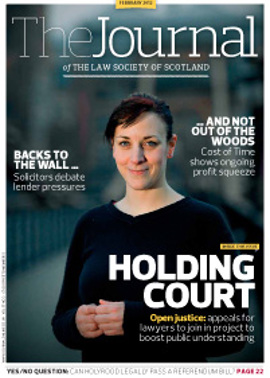Fuller benches

Waiving right to advice
Some weeks have passed since the Supreme Court issued its decisions in McGowan v B 2012 SLT 37 and the related cases of Jude and others v HM Advocate [2011] UKSC 55 (23 November 2011). All have collectively become known as “Grandsons of Cadder” and all dealt (albeit in slightly different ways) with the situation where someone in police custody is interviewed by the police, having been informed of their right to legal advice and having declined to exercise that right.
Without going into the twists and turns of the procedures which took the cases to London, nor indeed the detailed reasoning of the five judges, the one clear principle to emerge is that Strasbourg jurisprudence does not require that a person must have legal advice before they can be taken to have waived their right of access to a lawyer. If their actings in purportedly waiving the right are voluntary, informed and unequivocal, and attended by minimum safeguards commensurate to the importance of that right, then an effective waiver can be inferred. This of course means that the decision in each case will be fact-specific and thus for the court of first instance, where the matter can be explored in evidence.
Two other points from the judgments have particular resonance for current debates. First, in McGowan, Lord Hope makes some suggestions for changes in police practice in order to lessen the risk of misunderstanding; hopefully these will be taken forward. Secondly, from Jude comes the statement that it is not for the Supreme Court to say how the law and practice respecting crimes should be developed by the common law of Scotland. Need more be said?
“Adapted” for causing injury
It is trite law that offensive weapons fall into three classes: those which are offensive per se; those which are adapted for causing personal injury; and those which are intended for causing such injury by the person having the item in a public place. In Ashton v HM Advocate [2011] HCJAC 124 (9 December 2011) the sheriff had directed the jury to convict the accused, on the basis that the broken bottle was in the second category and on the evidence the accused had no lawful authority or reasonable excuse for having it with him. But the subsequent conviction under s 47(1) of the Criminal Law (Consolidation) (Scotland) Act 1995 has now been quashed, following a split decision in the appeal court.
The item in question consisted of the neck of a Budweiser bottle with jagged edges protruding from it. The accused, who was alone, in a wheelchair and in a public residential area, had told the police he intended to hit someone with it and that he had smashed the bottle to use it as a weapon, but in evidence said this was not true; he had phoned the police office with a false report in order to be arrested and thus obtain treatment for his drug addiction.
The majority in the appeal court (Lords Clarke and Osborne) agreed that it was not for the sheriff to decide a matter of fact in a jury case; it was not the law that a broken bottle must inevitably be regarded as an offensive weapon for the purposes of the statutory provisions. In his evidence, the accused had raised the possibility that the bottle was not adapted for use for causing injury to a person, something which should have been left to the jury to decide. But with this view Lord Hardie strongly dissented; what was relevant was whether, at the time the bottle was in the possession of an accused, it could be said to have been altered for use for any purpose; in the circumstances of the present case there was only one purpose for which a broken bottle could be used and that was to cause injury to a person; it could have no innocent use. Accordingly the sheriff had been correct to direct the jury to convict, having taken the view that the reason given in evidence by the appellant for possessing the broken bottle did not constitute a justifiable exception to the general prohibition contained in the legislation.
Du Plooy revisited
Everyone knows that s 196 of the Criminal (Procedure) (Scotland) Act 1995 has been productive of an enormous amount of case law on sentence discounting, especially after the landmark decision in Du Plooy v HM Advocate 2005 JC 1. Further general guidance on levels of discount was given in Spence v HM Advocate 2008 JC 174, but the whole subject has again come under scrutiny (by a bench of five judges) in seven conjoined appeals sub nom Gemmell v HM Advocate [2011] HCJAC 129 (20 December 2011).
Each case raised a different point in the discounting regime; in the result, separate opinions of the judges were issued, with a range of sometimes conflicting views. All require close study, but in this column it is possible only to list the principal issues to emerge from the court’s exhaustive scrutiny of the legislation and earlier cases. These include how the headline sentence should be computed; the discretionary element of discounting; its justification; when is it allowable; what is an early plea; what factors are (and are not) relevant; how a discount should be applied; whether public protection is ringfenced; what about extended sentences, driving disqualifications and the imposition of penalty points; and the risks of sentence discounting, including to public confidence in the criminal justice system and the credibility of sentences.
Further, the Lord Justice Clerk expressed the view that where a sentencer has given cogent reasons either for allowing the discount in question or for declining to apply a discount at all, it was only in exceptional circumstances that the appeal court should interfere.
Dealing specifically with issues of public protection, all members of the court took the view that while the whole period of a determinate sentence of imprisonment might be discounted, an extended sentence was in a different position: by statute, such a disposal was explicitly in two parts. The custodial term was imposed for punishment purposes and could be discounted, but the extension period, which is imposed where it is thought that licence conditions otherwise applicable would be insufficient, is imposed for the protection of the public and could not be discounted.
But (and by contrast), on the point whether a discount should be allowed on periods of disqualification and/or penalty points imposed in road traffic cases, the court was agreed that since such orders each constituted a “sentence” for the purposes of s 196, discounts (if otherwise appropriate) were competent, although a period of disqualification could never be reduced below the statutory minimum. As for penalty points, contrary to the view expressed in Stewart v Griffiths 2005 SCCR 291, such an order was a penalty and not just a warning to the accused. Accordingly, issues of public protection, such as those which apply in the case of extended sentences, were irrelevant.
When do summary proceedings commence?
The legislative provisions relating to the commencement of a summary prosecution are of course crucial from the standpoint of time bar in statutory cases; and they are designed to cover all the eventualities which might occur where citation (in whatever form) is not, cannot, or need not be effected against the accused. Needless to say, all of this has produced a steady stream of case law over the years, to which must now be added the five judge appeal in Chilcott v PF Stonehaven [2012] HCJAC 7 (12 January 2012).
There, the problems were that the accused was never cited at all on a (first) complaint for speeding; he later became aware of the charge when a (second) complaint was prepared and served on him; through agents he tendered a plea of not guilty at the last of the diets to which the first complaint had been continued without plea; and although that plea was later withdrawn and the second complaint fell as “not called”, his plea to the competency of the first complaint was repelled in the JP court.
That decision was upheld in the High Court, which (despite being referred to reported cases in this arcane field going back to 1836) declined to enter into what it described as “an archaeological examination” of the current statutory provisions. The key section of the Criminal Procedure (Scotland) Act 1995 was s 145A (added in 2003 and amended in 2007); this provides inter alia that (whether or not evidence of citation can be provided) where the accused is not present at the first calling of the case, the diet can be adjourned to allow him to be so. If he answers the complaint, either in person or through agents, then he is caught by s 144(8), which debars him from pleading want of due citation. The court remarked that s 145A may have brought about a change in the legal landscape in which earlier decisions of the court had been delivered, a change indeed urged in Lees v Malcolm 1992 JC 173.
In this issue
- Credit hire: a tug of war?
- As others see them
- Taking care of the dead
- Act like a trustee, think like a fund manager
- Beating the stress bug
- Reading for pleasure
- John McNeil, CBE, WS: an appreciation
- Opinion column: Open Justice
- Council profile
- Book reviews
- President's column
- On the move
- Between a rock and a hard place
- Tough times are still ahead
- Care: a new direction
- Officer class
- Open questions
- Fuller benches
- The limits of hearsay
- If you don't ask, you don't get?
- Fees: not so simple?
- Easing the debt block
- Registering our concerns
- Room at the top
- The best of times, the worst of times
- Law reform roundup
- Work and Cancer: employers’ toolkit
- From the Brussels office
- Post with caution
- Ask Ash
- The learning curve
- Business checklist
- Hear us, we say






